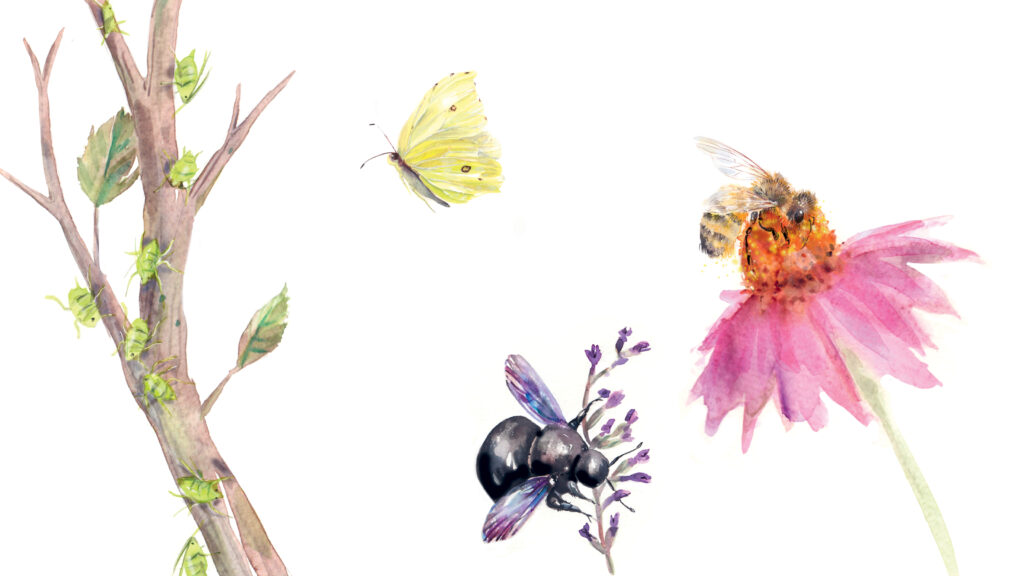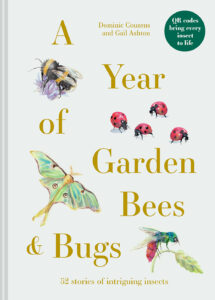A Year of Garden Bees & Bugs: The Peacock Butterfly

Could you spot a peacock butterfly? This is the time of year when they awake from their slumber. Discover their movements and how to spot them in this excerpt from A Year of Garden Bees & Bugs by Dominic Couzens and Gail Ashton.
By Dominic Couzens & Gail Ashton
The Peacock Butterfly is one of the signature sights of spring from western Europe to eastern Asia. Its bright, vermilion-red wings with large, sapphire eye spots make it among the most distinctive of butterflies.
By early March, the Palearctic days are lengthening and the sun’s warmth begins to penetrate winter’s frosty armour. The garden is giving us tantalizing glimpses of the summer to come; buds begin to open on trees and the hard, bare ground offers up small, green rosettes of fresh growth. Some of these nascent shoots may be part of your horticultural plan, and some may not, as seeds dispersed in the previous autumn’s winds have settled in your soil and are now taking their chances among your herbaceous borders. If you’re lucky, these interlopers will be stinging nettles. Yes, I do mean lucky, because the presence of this ‘bothersome weed’ ensures that this most stunning and beloved butterfly will be able to fulfil its ultimate destiny – to breed.
Come early spring and they will emerge from their slumber into the sunshine; sassy, semaphore beacons tumbling on the fresh spring breeze.
The peacock butterfly adult is highly cosmopolitan in its nectaring habits, visiting a wide range of flowers in our gardens, parks and field margins. The larvae (caterpillars), however, are much choosier, requiring copious quantities of stinging nettles to munch through on their journey to pupation. The adults overwinter and will seek out crevices in tree bark and walls, and even subterranean nooks such as rabbit holes, where they can survive in temperatures as low as –20 °C (–4 °F). Occasionally they will venture indoors to find somewhere to enter dormancy; you may have a surprise autumnal encounter with one in your house, garage or shed as one appears suddenly, disturbed from its cosy little nook when you draw the curtains, or run a duster down the side of your wardrobe.
Come early spring and they will emerge from their slumber into the sunshine; sassy, semaphore beacons tumbling on the fresh spring breeze. Males are highly territorial, and for good reason; they are in a race to claim the best nettle patches, because it is the best nettle patches that will secure a partner and therefore a continuation of their lineage. At this point in the season the vegetation is little more than ground cover, and the males need to get in early to secure prime real estate, ideally on a gentle slope in full sun. As more males emerge, things can start to get a little heated and fierce battles for territory erupt among the burgeoning foliage, as they joust and spar to claim their territories. The losers must vacate and take their chances elsewhere; the winners get to sit and wait for females to arrive, whereupon the fighting turns to wooing. Unusually for insects, peacock butterflies are monogamous – they will stick with one partner through the mating process. The female chooses the male with the most desirable attributes and – importantly – land, for this is where she will lay her eggs (50–80 on average, but sometimes up to 200) on the undersides of the greenest, freshest nettle leaves. The eggs, small, green and pinstriped like miniature gooseberries, hatch into tiny little caterpillars, which, after eating their own eggshells, immediately set to work on the tender shoots, moulting every week or so until, at around three weeks they are around 40 mm (51/2 in) long, velvety black and covered in formidable spines. Siblings tend to stick together, feeding en masse in large clusters that will rapidly strip vegetation. If threatened, the cluster will begin ‘shivering’ in sync with each other to deter predators.
When viewed upside down, the larger eye spots lead down into a point that looks remarkably like the face of a bird, which is known to startle avian aggressors.
The adults also have highly effective defence strategies. The undersides of the wings are dull, mottled brown, which provides superb camouflage and renders the butterfly virtually invisible in many circumstances. Should a predator, for example, a blue tit, see through the subterfuge and persist with its offensive, the peacock brings out the big guns. It flashes open those bright red wings vigorously, revealing the large eye spots. The purpose of this is to discombobulate its attacker, diverting attention from the soft, vulnerable body. When viewed upside down, the larger eye spots lead down into a point that looks remarkably like the face of a bird, which is known to startle avian aggressors. But that’s not all. The peacock can actually emit a warning noise too; the chafing together of the fore- and hindwings produces a broad-frequency hissing sound that is audible to humans. Studies show that this noise repels mice and other small rodents, proving that the peacock butterfly is not just a pretty ‘face’.
As more males emerge, things can start to get a little heated and fierce battles for territory erupt among the burgeoning foliage, as they joust and spar to claim their territories.
Watch the live-action movements of the Peacock Butterfly in the video below, featured in the book as part of a series of unique QR codes.
Discover more fascinating insects in A Year of Garden Bees & Bugs by Dominic Couzens and Gail Ashton. Out 14 March and available to pre-order now.


